2001 NISSAN PICK-UP maintenance schedule
[x] Cancel search: maintenance schedulePage 75 of 1306
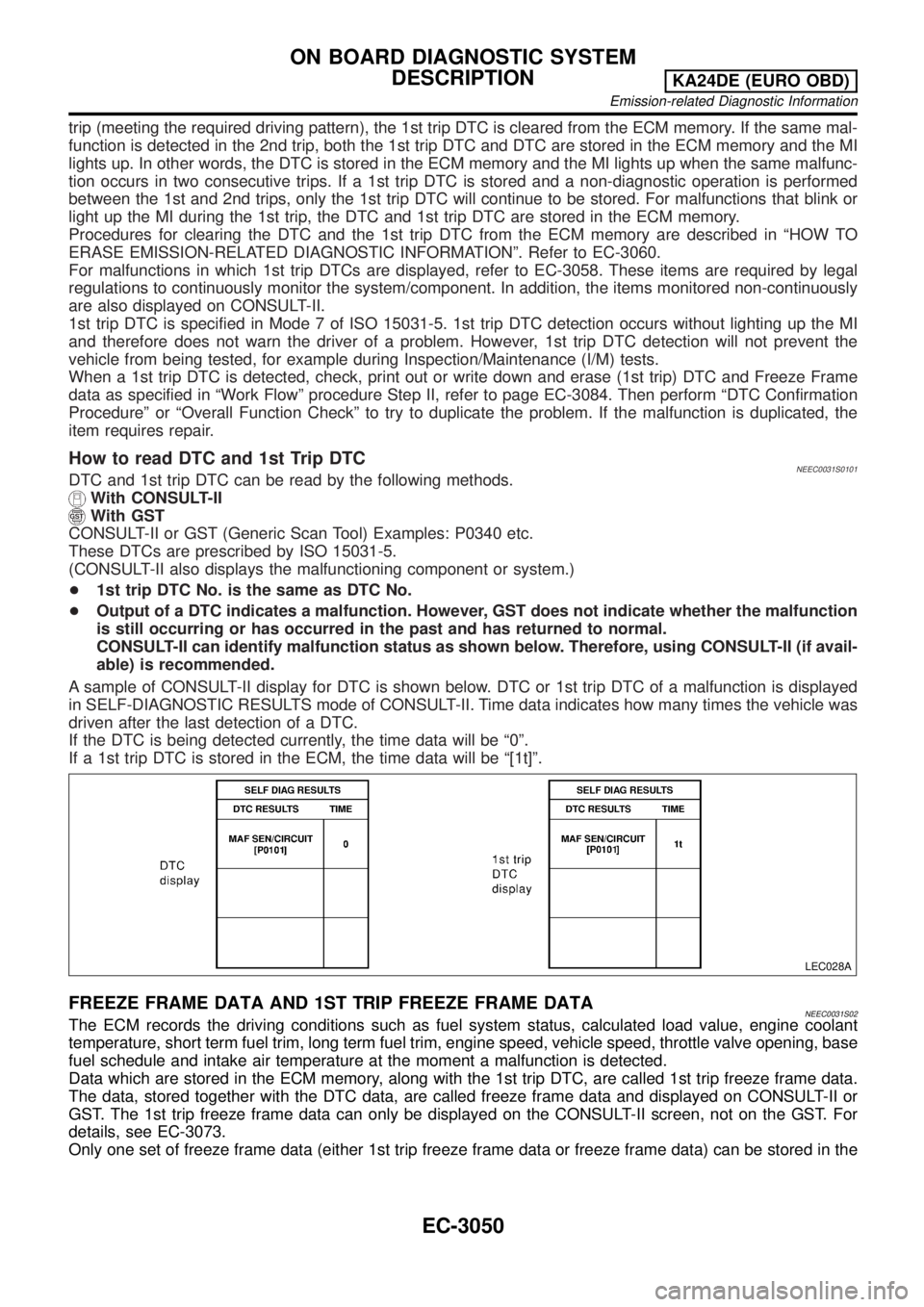
trip (meeting the required driving pattern), the 1st trip DTC is cleared from the ECM memory. If the same mal-
function is detected in the 2nd trip, both the 1st trip DTC and DTC are stored in the ECM memory and the MI
lights up. In other words, the DTC is stored in the ECM memory and the MI lights up when the same malfunc-
tion occurs in two consecutive trips. If a 1st trip DTC is stored and a non-diagnostic operation is performed
between the 1st and 2nd trips, only the 1st trip DTC will continue to be stored. For malfunctions that blink or
light up the MI during the 1st trip, the DTC and 1st trip DTC are stored in the ECM memory.
Procedures for clearing the DTC and the 1st trip DTC from the ECM memory are described in ªHOW TO
ERASE EMISSION-RELATED DIAGNOSTIC INFORMATIONº. Refer to EC-3060.
For malfunctions in which 1st trip DTCs are displayed, refer to EC-3058. These items are required by legal
regulations to continuously monitor the system/component. In addition, the items monitored non-continuously
are also displayed on CONSULT-II.
1st trip DTC is specified in Mode 7 of ISO 15031-5. 1st trip DTC detection occurs without lighting up the MI
and therefore does not warn the driver of a problem. However, 1st trip DTC detection will not prevent the
vehicle from being tested, for example during Inspection/Maintenance (I/M) tests.
When a 1st trip DTC is detected, check, print out or write down and erase (1st trip) DTC and Freeze Frame
data as specified in ªWork Flowº procedure Step II, refer to page EC-3084. Then perform ªDTC Confirmation
Procedureº or ªOverall Function Checkº to try to duplicate the problem. If the malfunction is duplicated, the
item requires repair.
How to read DTC and 1st Trip DTCNEEC0031S0101DTC and 1st trip DTC can be read by the following methods.
With CONSULT-II
With GST
CONSULT-II or GST (Generic Scan Tool) Examples: P0340 etc.
These DTCs are prescribed by ISO 15031-5.
(CONSULT-II also displays the malfunctioning component or system.)
+1st trip DTC No. is the same as DTC No.
+Output of a DTC indicates a malfunction. However, GST does not indicate whether the malfunction
is still occurring or has occurred in the past and has returned to normal.
CONSULT-II can identify malfunction status as shown below. Therefore, using CONSULT-II (if avail-
able) is recommended.
A sample of CONSULT-II display for DTC is shown below. DTC or 1st trip DTC of a malfunction is displayed
in SELF-DIAGNOSTIC RESULTS mode of CONSULT-II. Time data indicates how many times the vehicle was
driven after the last detection of a DTC.
If the DTC is being detected currently, the time data will be ª0º.
If a 1st trip DTC is stored in the ECM, the time data will be ª[1t]º.
LEC028A
FREEZE FRAME DATA AND 1ST TRIP FREEZE FRAME DATANEEC0031S02The ECM records the driving conditions such as fuel system status, calculated load value, engine coolant
temperature, short term fuel trim, long term fuel trim, engine speed, vehicle speed, throttle valve opening, base
fuel schedule and intake air temperature at the moment a malfunction is detected.
Data which are stored in the ECM memory, along with the 1st trip DTC, are called 1st trip freeze frame data.
The data, stored together with the DTC data, are called freeze frame data and displayed on CONSULT-II or
GST. The 1st trip freeze frame data can only be displayed on the CONSULT-II screen, not on the GST. For
details, see EC-3073.
Only one set of freeze frame data (either 1st trip freeze frame data or freeze frame data) can be stored in the
ON BOARD DIAGNOSTIC SYSTEM
DESCRIPTION
KA24DE (EURO OBD)
Emission-related Diagnostic Information
EC-3050
Page 97 of 1306
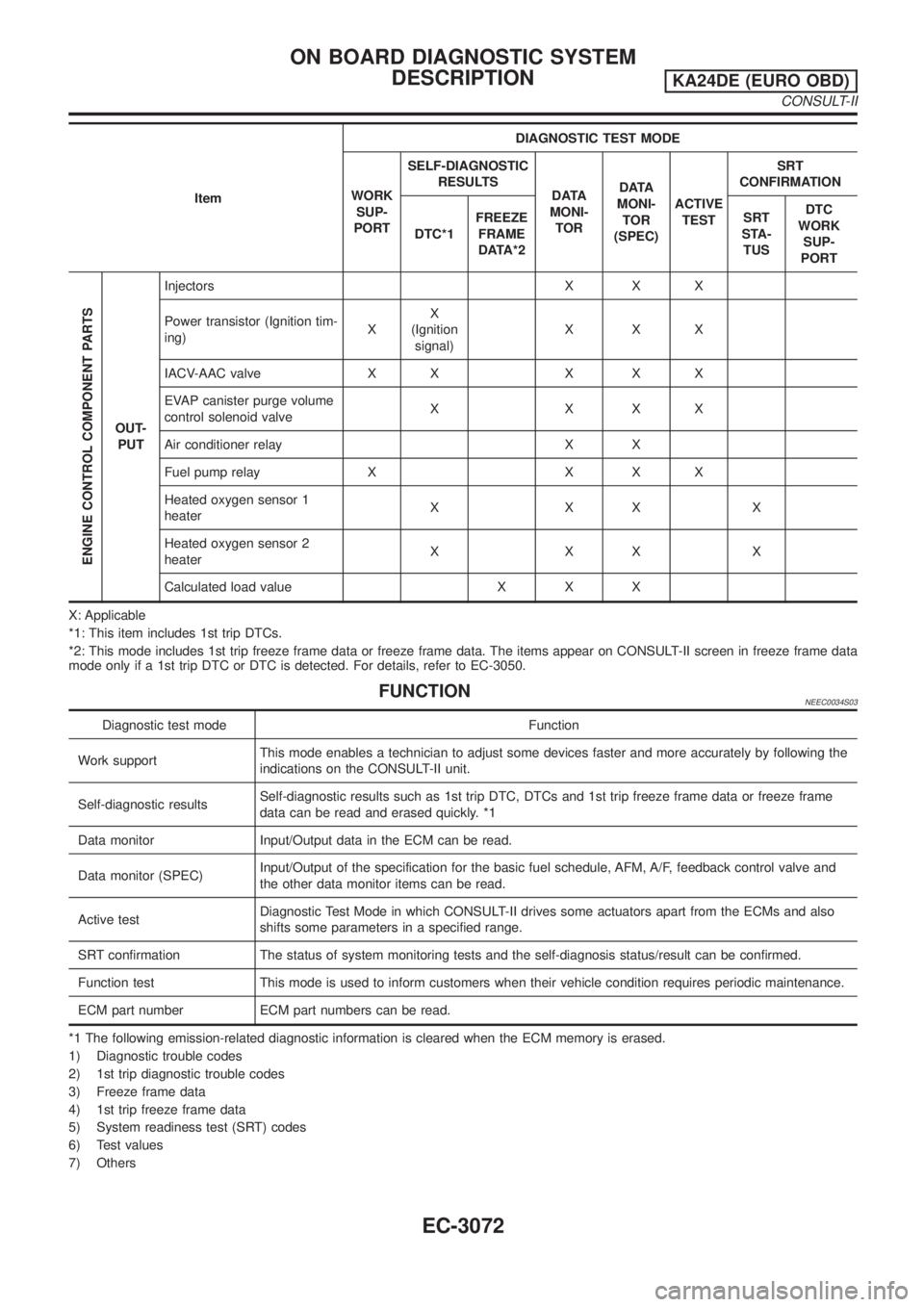
ItemDIAGNOSTIC TEST MODE
WORK
SUP-
PORTSELF-DIAGNOSTIC
RESULTS
DATA
MONI-
TORDATA
MONI-
TOR
(SPEC)ACTIVE
TESTSRT
CONFIRMATION
DTC*1FREEZE
FRAME
DATA*2SRT
STA-
TUSDTC
WORK
SUP-
PORT
ENGINE CONTROL COMPONENT PARTS
OUT-
PUTInjectors X X X
Power transistor (Ignition tim-
ing)XX
(Ignition
signal)XXX
IACV-AAC valve X X X X X
EVAP canister purge volume
control solenoid valveXXXX
Air conditioner relay X X
Fuel pump relay X X X X
Heated oxygen sensor 1
heaterXXXX
Heated oxygen sensor 2
heaterXXXX
Calculated load value X X X
X: Applicable
*1: This item includes 1st trip DTCs.
*2: This mode includes 1st trip freeze frame data or freeze frame data. The items appear on CONSULT-II screen in freeze frame data
mode only if a 1st trip DTC or DTC is detected. For details, refer to EC-3050.
FUNCTIONNEEC0034S03
Diagnostic test mode Function
Work supportThis mode enables a technician to adjust some devices faster and more accurately by following the
indications on the CONSULT-II unit.
Self-diagnostic resultsSelf-diagnostic results such as 1st trip DTC, DTCs and 1st trip freeze frame data or freeze frame
data can be read and erased quickly. *1
Data monitor Input/Output data in the ECM can be read.
Data monitor (SPEC)Input/Output of the specification for the basic fuel schedule, AFM, A/F, feedback control valve and
the other data monitor items can be read.
Active testDiagnostic Test Mode in which CONSULT-II drives some actuators apart from the ECMs and also
shifts some parameters in a specified range.
SRT confirmation The status of system monitoring tests and the self-diagnosis status/result can be confirmed.
Function test This mode is used to inform customers when their vehicle condition requires periodic maintenance.
ECM part number ECM part numbers can be read.
*1 The following emission-related diagnostic information is cleared when the ECM memory is erased.
1) Diagnostic trouble codes
2) 1st trip diagnostic trouble codes
3) Freeze frame data
4) 1st trip freeze frame data
5) System readiness test (SRT) codes
6) Test values
7) Others
ON BOARD DIAGNOSTIC SYSTEM
DESCRIPTION
KA24DE (EURO OBD)
CONSULT-II
EC-3072
Page 111 of 1306

Basic InspectionNEEC0038Precaution:
Perform Basic Inspection without electrical or mechanical
loads applied;
+Headlamp switch is OFF,
+Air conditioner switch is OFF,
+Rear window defogger switch is OFF,
+Steering wheel is in the straight-ahead position, etc.
1 INSPECTION START
1. Check service records for any recent repairs that may indicate a related problem, or the current need for scheduled
maintenance.
2. Open engine hood and check the following:
+Harness connectors for improper connections
+Vacuum hoses for splits, kinks, or improper connections
+Wiring for improper connections, pinches, or cuts
SEF142I
With CONSULT-II©GO TO 2.
With GST©GO TO 4.
No tools©GO TO 5.
2 CONNECT CONSULT-II TO THE VEHICLE
Connect ªCONSULT-IIº to the data link connector and select ªENGINEº from the menu. Refer to EC-3070.
SEC305D
©GO TO 3.
TROUBLE DIAGNOSIS Ð BASIC
INSPECTION
KA24DE (EURO OBD)
Basic Inspection
EC-3086
Page 469 of 1306

Basic Inspection
Precaution:
Perform Basic Inspection without electrical or mechanical
loads applied;
+Shift lever is in neutral position,
+Heat up switch is OFF,
+Headlamp switch is OFF,
+Air conditioner switch is OFF,
+Rear defogger switch is OFF,
+Steering wheel is in the straight-ahead position, etc.
1 INSPECTION START
1. Check service records for any recent repairs that may indicate a related problem.
2. Check the current need for scheduled maintenance, especially for fuel filter and air cleaner filter. Refer to MA section.
3. Open engine hood and check the following:
+Harness connectors for improper connections
+Vacuum hoses for splits, kinks, or improper connections
+Wiring for improper connections, pinches, or cuts
SEF142I
4. Start engine and warm it up to the normal operating temperature.
cGO TO 2.
2 PREPARATION FOR CHECKING IDLE SPEED
With CONSULT-II
Connect CONSULT-II to the data link connector.
Without CONSULT-II
Install diesel tacho tester to the vehicle.
cGO TO 3.
TROUBLE DIAGNOSIS Ð BASIC INSPECTIONYD25DDTi
EC-3444
Page 1023 of 1306
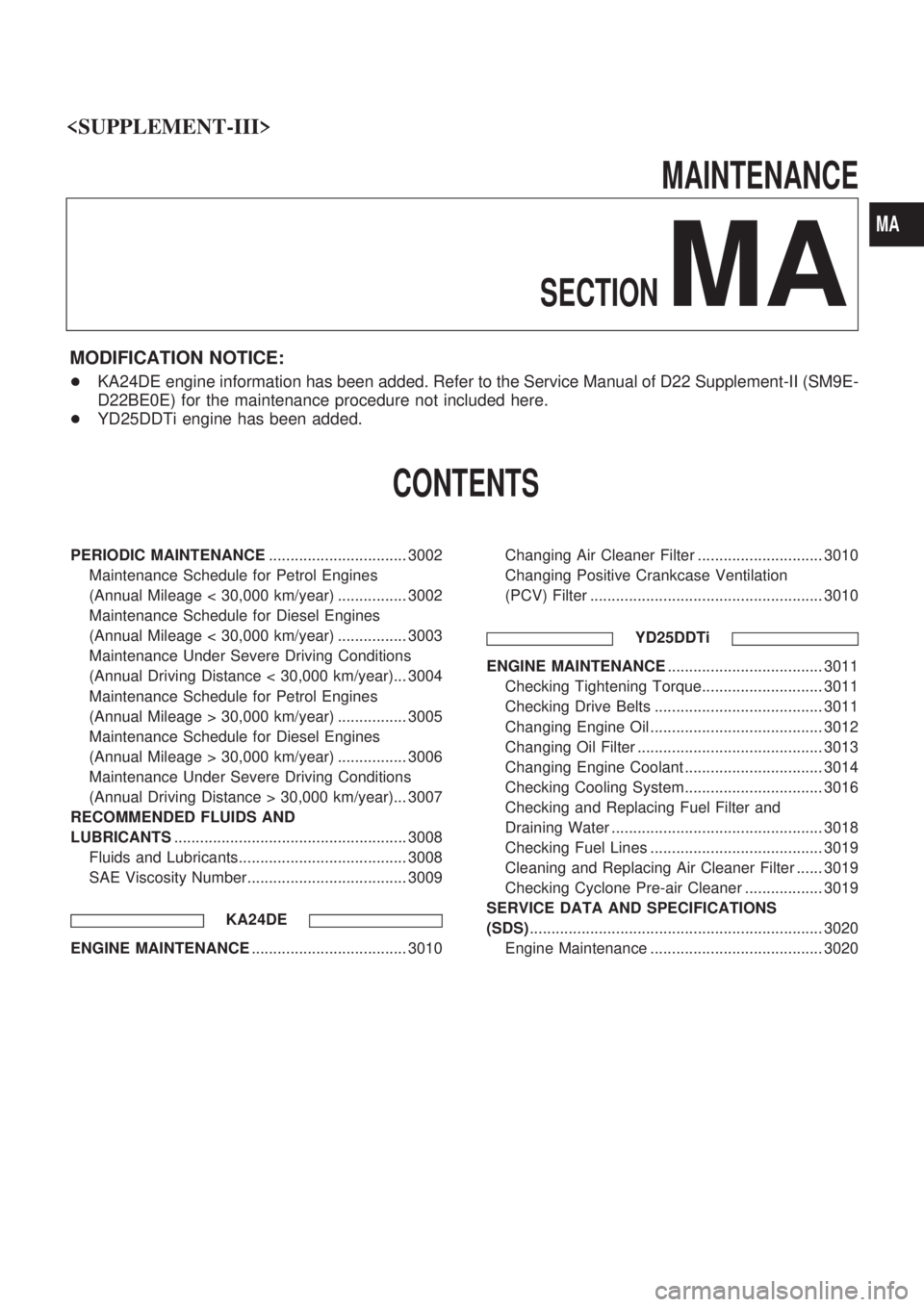
MAINTENANCE
SECTION
MA
MODIFICATION NOTICE:
+KA24DE engine information has been added. Refer to the Service Manual of D22 Supplement-II (SM9E-
D22BE0E) for the maintenance procedure not included here.
+YD25DDTi engine has been added.
CONTENTS
PERIODIC MAINTENANCE................................ 3002
Maintenance Schedule for Petrol Engines
(Annual Mileage < 30,000 km/year) ................ 3002
Maintenance Schedule for Diesel Engines
(Annual Mileage < 30,000 km/year) ................ 3003
Maintenance Under Severe Driving Conditions
(Annual Driving Distance < 30,000 km/year)... 3004
Maintenance Schedule for Petrol Engines
(Annual Mileage > 30,000 km/year) ................ 3005
Maintenance Schedule for Diesel Engines
(Annual Mileage > 30,000 km/year) ................ 3006
Maintenance Under Severe Driving Conditions
(Annual Driving Distance > 30,000 km/year)... 3007
RECOMMENDED FLUIDS AND
LUBRICANTS...................................................... 3008
Fluids and Lubricants....................................... 3008
SAE Viscosity Number..................................... 3009
KA24DE
ENGINE MAINTENANCE.................................... 3010Changing Air Cleaner Filter ............................. 3010
Changing Positive Crankcase Ventilation
(PCV) Filter ...................................................... 3010
YD25DDTi
ENGINE MAINTENANCE.................................... 3011
Checking Tightening Torque............................ 3011
Checking Drive Belts ....................................... 3011
Changing Engine Oil ........................................ 3012
Changing Oil Filter ........................................... 3013
Changing Engine Coolant ................................ 3014
Checking Cooling System................................ 3016
Checking and Replacing Fuel Filter and
Draining Water ................................................. 3018
Checking Fuel Lines ........................................ 3019
Cleaning and Replacing Air Cleaner Filter ...... 3019
Checking Cyclone Pre-air Cleaner .................. 3019
SERVICE DATA AND SPECIFICATIONS
(SDS).................................................................... 3020
Engine Maintenance ........................................ 3020
MA
Page 1024 of 1306
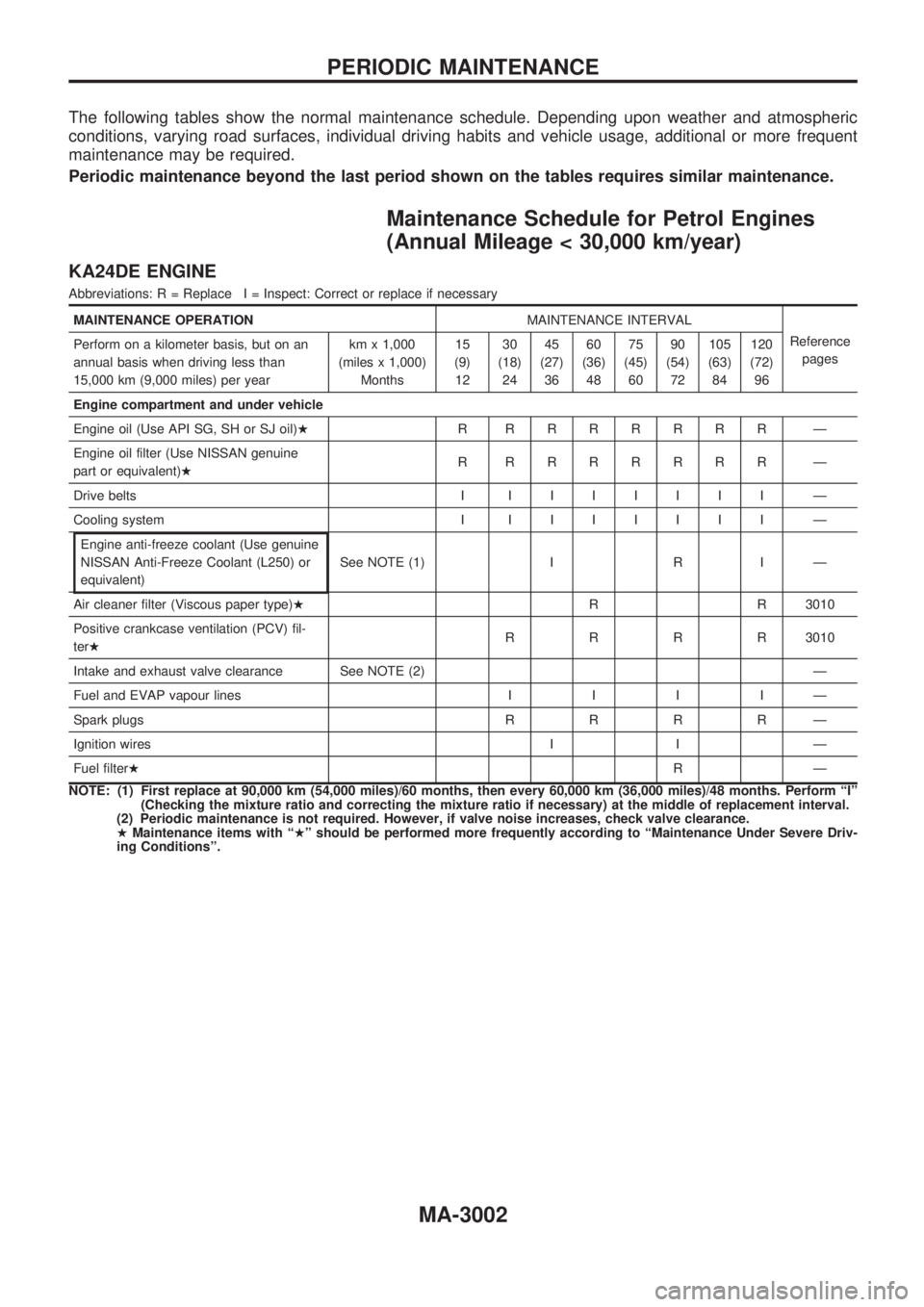
The following tables show the normal maintenance schedule. Depending upon weather and atmospheric
conditions, varying road surfaces, individual driving habits and vehicle usage, additional or more frequent
maintenance may be required.
Periodic maintenance beyond the last period shown on the tables requires similar maintenance.
Maintenance Schedule for Petrol Engines
(Annual Mileage < 30,000 km/year)
KA24DE ENGINE
Abbreviations: R = Replace I = Inspect: Correct or replace if necessary
MAINTENANCE OPERATIONMAINTENANCE INTERVAL
Reference
pages Perform on a kilometer basis, but on an
annual basis when driving less than
15,000 km (9,000 miles) per yearkm x 1,000
(miles x 1,000)
Months15
(9)
1230
(18)
2445
(27)
3660
(36)
4875
(45)
6090
(54)
72105
(63)
84120
(72)
96
Engine compartment and under vehicle
Engine oil (Use API SG, SH or SJ oil)HR RRRRRRR Ð
Engine oil filter (Use NISSAN genuine
part or equivalent)HR RRRRRRR Ð
Drive belts IIIIIIII Ð
Cooling system IIIIIIII Ð
Engine anti-freeze coolant (Use genuine
NISSAN Anti-Freeze Coolant (L250) or
equivalent)See NOTE (1) I R I Ð
Air cleaner filter (Viscous paper type)HR R 3010
Positive crankcase ventilation (PCV) fil-
terHRRRR3010
Intake and exhaust valve clearance See NOTE (2) Ð
Fuel and EVAP vapour linesIIIIÐ
Spark plugsRRRRÐ
Ignition wires I I Ð
Fuel filterHRÐ
NOTE: (1) First replace at 90,000 km (54,000 miles)/60 months, then every 60,000 km (36,000 miles)/48 months. Perform ªIº
(Checking the mixture ratio and correcting the mixture ratio if necessary) at the middle of replacement interval.
(2) Periodic maintenance is not required. However, if valve noise increases, check valve clearance.
HMaintenance items with ªHº should be performed more frequently according to ªMaintenance Under Severe Driv-
ing Conditionsº.
PERIODIC MAINTENANCE
MA-3002
Page 1025 of 1306
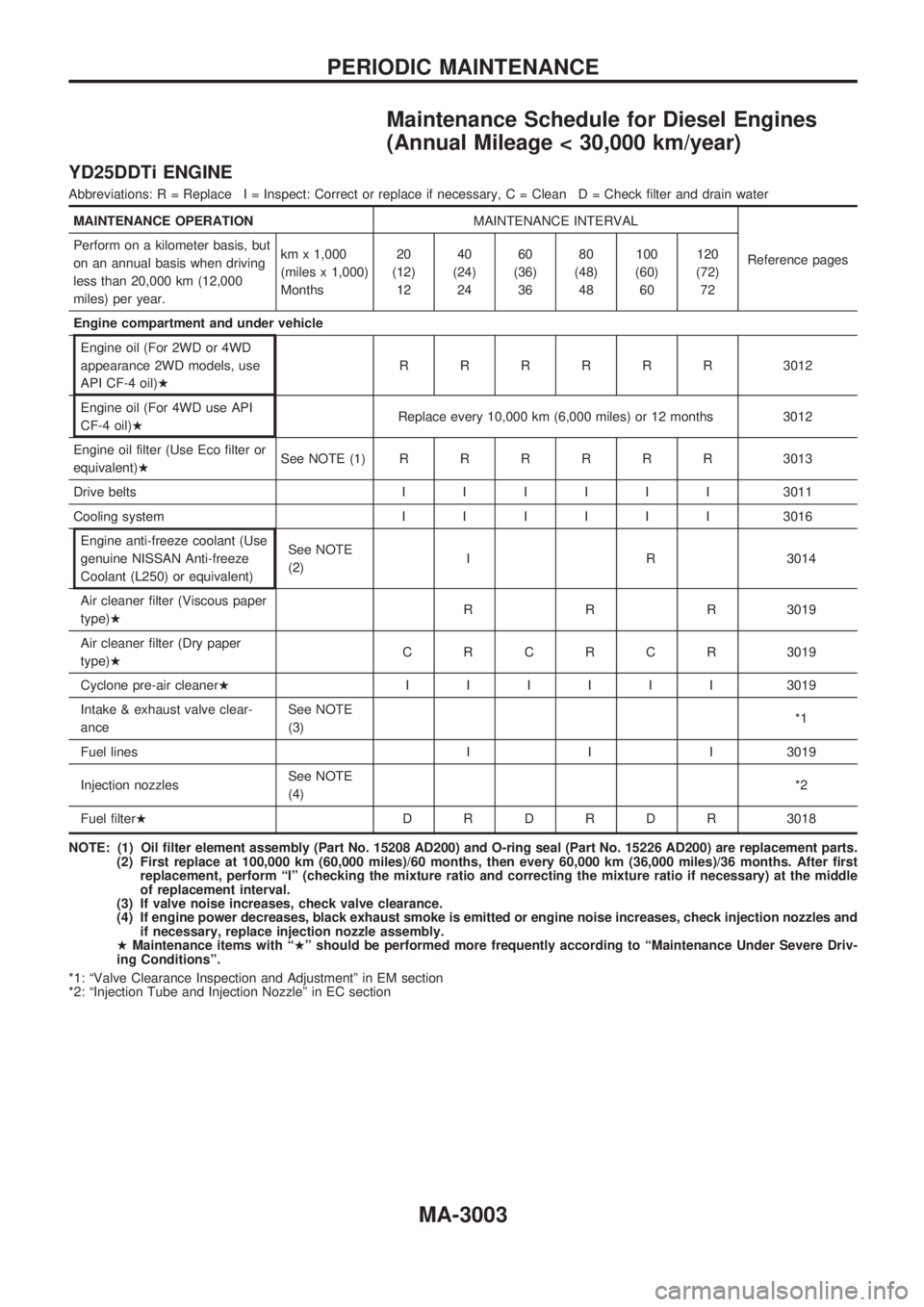
Maintenance Schedule for Diesel Engines
(Annual Mileage < 30,000 km/year)
YD25DDTi ENGINE
Abbreviations: R = Replace I = Inspect: Correct or replace if necessary, C = Clean D = Check filter and drain water
MAINTENANCE OPERATIONMAINTENANCE INTERVAL
Reference pages Perform on a kilometer basis, but
on an annual basis when driving
less than 20,000 km (12,000
miles) per year.km x 1,000
(miles x 1,000)
Months20
(12)
1240
(24)
2460
(36)
3680
(48)
48100
(60)
60120
(72)
72
Engine compartment and under vehicle
Engine oil (For 2WD or 4WD
appearance 2WD models, use
API CF-4 oil)HRRRRRR3012
Engine oil (For 4WD use API
CF-4 oil)HReplace every 10,000 km (6,000 miles) or 12 months 3012
Engine oil filter (Use Eco filter or
equivalent)HSee NOTE (1)RRRRRR3013
Drive beltsIIIIII3011
Cooling systemIIIIII3016
Engine anti-freeze coolant (Use
genuine NISSAN Anti-freeze
Coolant (L250) or equivalent)See NOTE
(2)I R 3014
Air cleaner filter (Viscous paper
type)HR R R 3019
Air cleaner filter (Dry paper
type)HCRCRCR3019
Cyclone pre-air cleanerHIIIIII3019
Intake & exhaust valve clear-
anceSee NOTE
(3)*1
Fuel lines I I I 3019
Injection nozzlesSee NOTE
(4)*2
Fuel filterHDRDRDR3018
NOTE: (1) Oil filter element assembly (Part No. 15208 AD200) and O-ring seal (Part No. 15226 AD200) are replacement parts.
(2) First replace at 100,000 km (60,000 miles)/60 months, then every 60,000 km (36,000 miles)/36 months. After first
replacement, perform ªIº (checking the mixture ratio and correcting the mixture ratio if necessary) at the middle
of replacement interval.
(3) If valve noise increases, check valve clearance.
(4) If engine power decreases, black exhaust smoke is emitted or engine noise increases, check injection nozzles and
if necessary, replace injection nozzle assembly.
HMaintenance items with ªHº should be performed more frequently according to ªMaintenance Under Severe Driv-
ing Conditionsº.
*1: ªValve Clearance Inspection and Adjustmentº in EM section
*2: ªInjection Tube and Injection Nozzleº in EC section
PERIODIC MAINTENANCE
MA-3003
Page 1027 of 1306
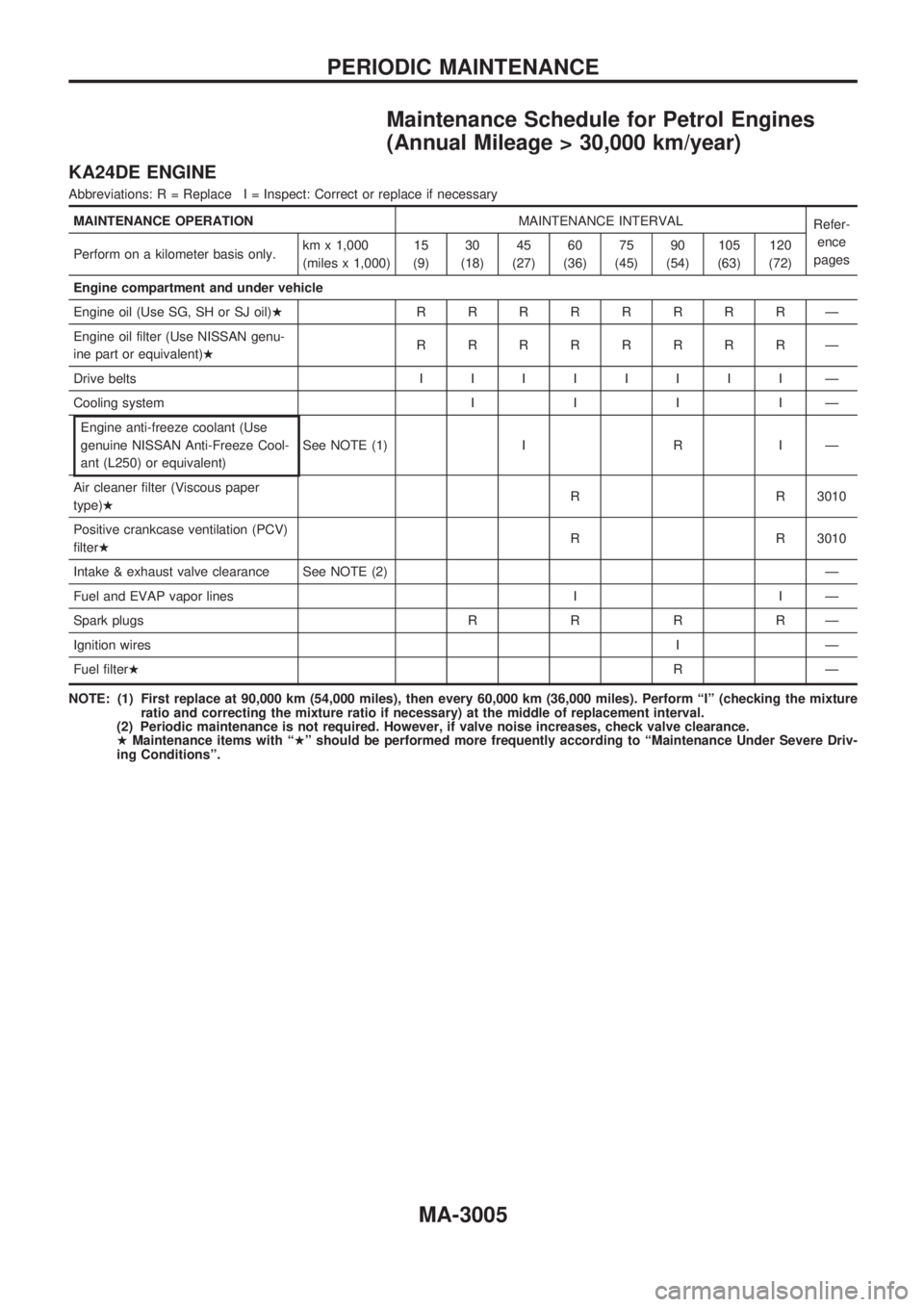
Maintenance Schedule for Petrol Engines
(Annual Mileage > 30,000 km/year)
KA24DE ENGINE
Abbreviations: R = Replace I = Inspect: Correct or replace if necessary
MAINTENANCE OPERATIONMAINTENANCE INTERVAL
Refer-
ence
pages Perform on a kilometer basis only.km x 1,000
(miles x 1,000)15
(9)30
(18)45
(27)60
(36)75
(45)90
(54)105
(63)120
(72)
Engine compartment and under vehicle
Engine oil (Use SG, SH or SJ oil)HRRRRRRRRÐ
Engine oil filter (Use NISSAN genu-
ine part or equivalent)HRRRRRRRRÐ
Drive beltsIIIIIIIIÐ
Cooling systemIIIIÐ
Engine anti-freeze coolant (Use
genuine NISSAN Anti-Freeze Cool-
ant (L250) or equivalent)See NOTE (1) I R I Ð
Air cleaner filter (Viscous paper
type)HR R 3010
Positive crankcase ventilation (PCV)
filterHR R 3010
Intake & exhaust valve clearance See NOTE (2)Ð
Fuel and EVAP vapor lines I I Ð
Spark plugsRRRRÐ
Ignition wiresIÐ
Fuel filterHRÐ
NOTE: (1) First replace at 90,000 km (54,000 miles), then every 60,000 km (36,000 miles). Perform ªIº (checking the mixture
ratio and correcting the mixture ratio if necessary) at the middle of replacement interval.
(2) Periodic maintenance is not required. However, if valve noise increases, check valve clearance.
HMaintenance items with ªHº should be performed more frequently according to ªMaintenance Under Severe Driv-
ing Conditionsº.
PERIODIC MAINTENANCE
MA-3005